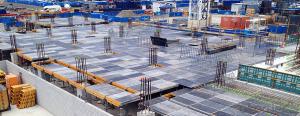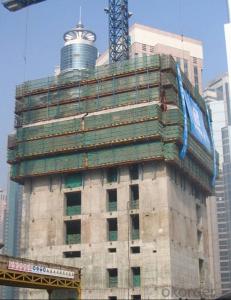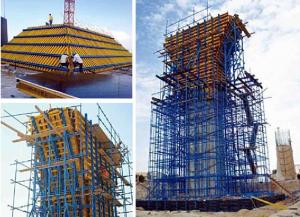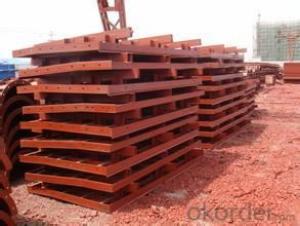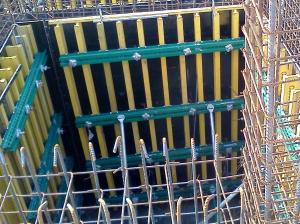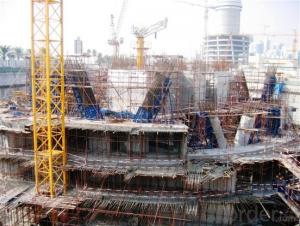Concrete Slab Formwork Scaffolding System Formwork Iron Scaffolding High Quality
- Loading Port:
- Tianjin
- Payment Terms:
- TT OR LC
- Min Order Qty:
- 10000 set
- Supply Capability:
- 50000 set/month
OKorder Service Pledge
OKorder Financial Service
You Might Also Like
Concrete Slab Formwork Scaffolding System Formwork Iron Scaffolding High Quality
Circular Column Formwork Outrigger For Scaffolding With New Design
Plastic Formwork Concrete Formwork Circular Column Used Scaffolding Props New Design
Developing with new technology materials, steel formworks is no longer a must in construction concrete process. More and more buildings are established with plastic formworks. And workers love this new formworks much more.
Concrete Slab Formwork Scaffolding System Formwork Iron Scaffolding High Quality
The advantages of plastic formworks:
1.First of all--light
Yes it is the first advantage of plastic formwork. It wins the great praise of both contractors and workers.
The biggest panel is 120×1500px,weights 10.5kg only. It can be lift and set up by one person easily, which means there is no need for cranes on site.Saves a lot of cost and time.
2.Easy set up
Different size of panels can firmly locked by simply turn the special handles to 90 degree. The Panels has rib on the back, which makes the system need not traditional wood blocks and nails. The panels have holes to fit tie rod, guarantee the strength of the whole system.
3.Modularity
Modular formworks composed by different size of panels..
4.Strength
The handles are made by high strength Nilon, each panel locked by at least 4 handles, which makes the whole system strong enough to pour 1000px walls.
5.Environment friendly
The system needs no cut and nail due to the variety size. Also it needs nearly no wood. The material can be recycled after broken, so it will not pollute the environment.
6.Consequent
Concrete does not stick to plastic formwork, thus the panels need no oil before using, and can be cleaned simply by water. The surface of the wall which build by modular formwork is smooth and without rework.
Concrete Slab Formwork Scaffolding System Formwork Iron Scaffolding High Quality
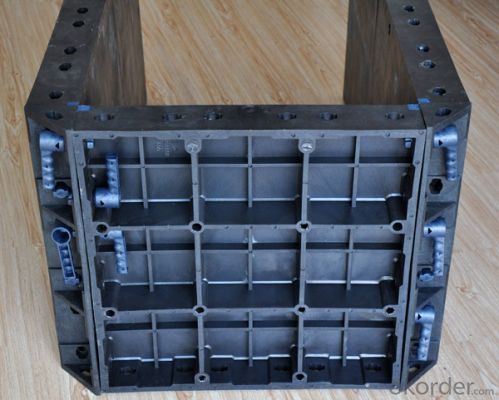
Concrete Slab Formwork Scaffolding System Formwork Iron Scaffolding High Quality
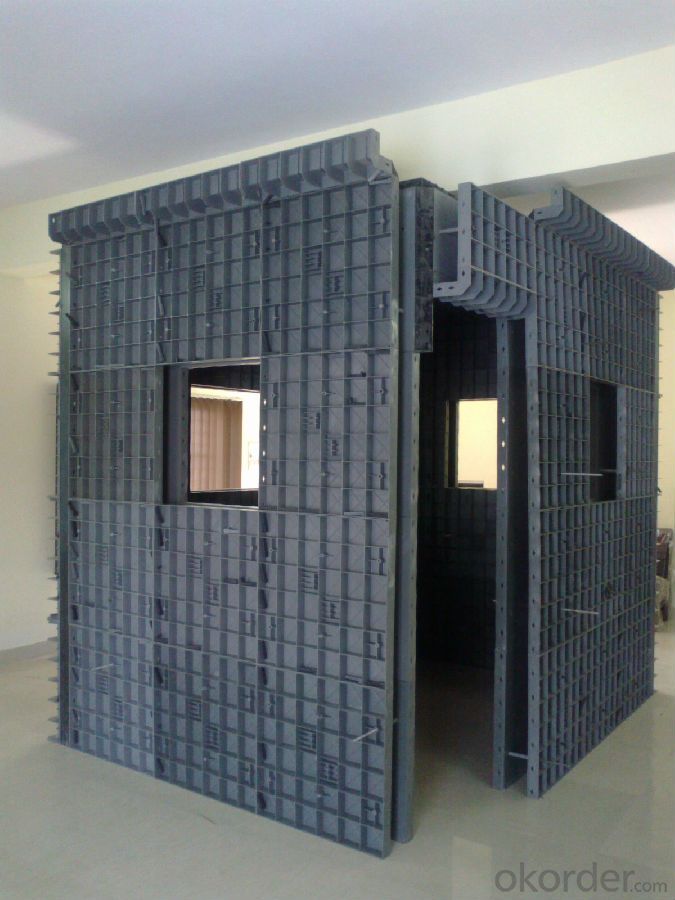
Concrete Slab Formwork Scaffolding System Formwork Iron Scaffolding High Quality
Advantage
* Good loading capacity
* Easy to assemble and dismantle
* Stable and durable thanks to its structual design & automatic welding quality
* Customized solution helps you work safe, save cost and convenient
* Excellent quality for formwork & scaffolding with wide choices
Packing
in bulk or in bundle, or as requested
Shipping
15-20 Days.
Normally small orders, it needs just 15-20 business days to the port. For goods with stock, it would be even shoter.
Concrete Slab Formwork Scaffolding System Formwork Iron Scaffolding High Quality
Other scaffolding & formwork products:
(1) Scaffolding System:
Including Ringlock Scaffolding System and accessories; Cuplock Scaffolding System and accessories; Kwikstage Scaffolding System and accessories; Haki Scaffolding System and accessories;
(2) Scaffolding Frame & Accessories:
Including Walk Through Frame Scaffolding; Ladder Frame Scaffolding; Accessories; we also can make scaffolding according to your samples or drawings.
(3) Scaffolding Couplers/Clamps:
We can produce all kinds of forged and pressed couplers, including British type couplers, American type couplers, German type couplers, Italian type couplers ,fence couplers, BRC coplers and so on. We also can produce according to your drawings or samples.
Concrete Slab Formwork Scaffolding System Formwork Iron Scaffolding High Quality
FAQ
Why Us?
We are one of the Top 500 in the world, largest construction materials supplier in China. Also we are a state-owned company and respond to every customer with large and also small orders.
We own professional manufacturers with powerful producing capacity.
Extensive and comprehensive quality control system
Excellent products with competitive prices.
Efficient services in pre and after sale.
Full energy with affluent experience team.
- Q:How does steel frame formwork prevent the formation of surface defects in the concrete?
- To ensure the smooth and accurate placement of concrete during construction, steel frame formwork plays a vital role in preventing surface defects. Firstly, it offers a stable and rigid structure that prevents any movement or shifting during pouring and curing. This stability allows the concrete to settle evenly, reducing the risk of cracks or unevenness. Secondly, the durability and resistance to deformation of steel frame formwork ensure it can withstand the pressure exerted by the concrete without bending or warping. This prevents any distortions that could lead to imperfections in the concrete. Additionally, the smooth and seamless design of steel frame formwork minimizes the chances of concrete leakage or seepage, which can cause honeycombing or voids. By containing the concrete effectively, it ensures a consistent and defect-free surface finish. Furthermore, steel frame formwork allows for precise control over the pouring process, easily adjusted and leveled for accurate placement and uniform thickness. This precision prevents unevenness or irregularities, resulting in a smoother and more aesthetically pleasing end product. In conclusion, steel frame formwork maintains stability, durability, smoothness, and precision to prevent surface defects in concrete, resulting in a high-quality finish without imperfections.
- Q:What safety measures need to be taken when using steel frame formwork?
- To ensure the well-being of workers and the overall success of the construction project, it is important to take several safety measures when using steel frame formwork. These measures include: 1. Providing adequate training: Workers should receive proper training on how to handle and assemble steel frame formwork. This includes understanding the correct procedures for setting up, dismantling, and moving the formwork. 2. Conducting regular inspections and maintenance: It is essential to regularly inspect the steel frame formwork to identify any potential hazards or defects. Any damaged or faulty parts should be repaired or replaced immediately to prevent accidents. 3. Ensuring secure anchorage: It is crucial to securely anchor the steel frame formwork to the supporting structure to prevent unexpected movements or collapse, reducing the risk of injuries. 4. Providing fall protection: Workers should be given appropriate fall protection measures when working at heights on the steel frame formwork. This may involve using safety harnesses, guardrails, or safety nets. 5. Promoting proper lifting techniques: Workers should use proper lifting techniques when moving or handling steel frame formwork to avoid strains or injuries. Mechanical lifting equipment, such as cranes or forklifts, should be utilized to minimize physical strain. 6. Encouraging clear communication: Effective communication between workers is important to ensure everyone understands their roles and responsibilities when working with steel frame formwork. Clear instructions and signage should be provided to prevent misunderstandings or confusion. 7. Providing adequate lighting and ventilation: Proper lighting and ventilation should be available in the area where steel frame formwork is being used. This will improve visibility and reduce the risk of accidents caused by poor lighting or inadequate air circulation. 8. Supplying personal protective equipment (PPE): Workers should be given the necessary PPE, such as hard hats, safety goggles, gloves, and steel toe boots, to protect them from potential hazards. By implementing these safety measures, construction companies can minimize the risks associated with using steel frame formwork, creating a safer working environment for their employees and ensuring a successful construction project.
- Q:What are the different types of concrete release agents used with steel frame formwork?
- Steel frame formwork can be used with various types of concrete release agents. These agents are applied to the formwork surface to prevent concrete from adhering to it during the pouring and curing process. A commonly used release agent is petroleum-based. These agents are typically oil-based and create a barrier between the formwork and the concrete. They are simple to apply and provide a seamless release, facilitating easy removal of the formwork once the concrete has cured. However, it is important to note that petroleum-based release agents can be flammable and have potential negative effects on the environment. Another type of release agent for concrete is water-based. These agents are usually composed of water, surfactants, and other additives. They are non-toxic and environmentally friendly, making them a popular choice among contractors. Water-based release agents are easy to apply and result in a clean release, leaving minimal or no residue on the formwork. Moreover, there are specialty release agents available for specific applications. For instance, some agents are designed to create a textured finish on the concrete surface, while others are formulated for use with colored or decorative concrete. These specialty agents assist in achieving desired finishes or appearances. Aside from the various types of release agents, they can also be applied in different forms. Some release agents are in liquid form, which can be sprayed or brushed onto the formwork. Others are available as release agent film or tape, which can be directly applied to the formwork surface. The choice of application method depends on the project's specific requirements and the contractor's preferences. In conclusion, the use of different types of concrete release agents with steel frame formwork provides a range of options to ensure effortless and efficient removal of the formwork, as well as a smooth and clean finish on the concrete surface. Contractors should consider factors such as environmental impact, ease of application, and desired finish when selecting the appropriate release agent for their project.
- Q:How does steel frame formwork help in reducing construction errors?
- Steel frame formwork helps in reducing construction errors by providing a strong and stable structure for concrete pouring. It ensures accurate alignment and measurement, preventing deviations and inconsistencies in the final construction. With its robustness and precision, steel frame formwork minimizes the risk of mistakes such as uneven walls or floors, misplaced openings, or structural deficiencies, resulting in a more efficient and error-free construction process.
- Q:What types of building templates
- The frame and rib of the light steel frame plywood template are cold formed steel, or the frame is hollow steel frame, and the ribs are cold formed steel. The characteristics of these templates are steel frame strength and stiffness, template assembly, and does not need additional Strh, only the ribs can be fixed clamping fixture two templates, so the installation speed is faster, saving labor and material, very convenient.
- Q:Can steel frame formwork be used in projects with limited access or space constraints?
- Yes, steel frame formwork can be used in projects with limited access or space constraints. Steel frame formwork is highly versatile and can be easily adapted to fit into tight spaces or areas with limited access. Its modular nature allows for flexibility in design and assembly, making it a suitable solution for such projects. Additionally, steel frame formwork is lightweight and easy to handle, enabling efficient transportation and installation even in confined spaces.
- Q:What are the different types of locking systems used with steel frame formwork?
- Steel frame formwork employs a variety of locking systems to ensure stability and preserve the integrity of the structure. 1. The Wedge Locking System, commonly used, secures formwork panels by inserting wedges into frame slots and tightening them for proper alignment and stability. 2. In the Pin Locking System, formwork panels are locked together using pins inserted through frame holes and secured with clips or locking devices. This system allows for fast assembly and disassembly. 3. The Clamp Locking System utilizes clamps attached to the frames to tightly hold the formwork panels together. It offers flexibility for adjusting the formwork and is suitable for curved or irregular structures. 4. With the Hook Locking System, hooks are employed to connect the formwork panels. The hooks are inserted into frame slots and secured with locking mechanisms, ensuring a robust and dependable connection during concrete pouring. 5. Toggle Locking Systems use toggle clamps attached to the frames to create a secure bond between the formwork panels. This system is commonly used in large-scale construction projects that require a high level of stability. 6. The Magnetic Locking System is a newer method that relies on magnets embedded in the frames to hold the formwork panels together. The panels are magnetically attached to the magnetic strips, allowing for quick and easy installation and improved flexibility in adjusting the formwork. The selection of the appropriate locking system depends on factors such as the formwork design, structural demands, ease of assembly and disassembly, as well as overall efficiency and safety considerations for the specific construction project.
- Q:Can steel frame formwork be used for the construction of cultural facilities?
- Certainly! Steel frame formwork is a viable option for constructing cultural facilities. Its versatility and durability make it an excellent choice for creating strong and stable structures. It is commonly used in various construction projects, including museums, theaters, and art galleries. There are several advantages to using steel frame formwork in the construction of cultural facilities. Firstly, it offers a high level of flexibility and adaptability, allowing for the creation of intricate and visually appealing designs. This is especially important in cultural facilities that often incorporate unique architectural features and artistic elements. Additionally, steel frame formwork has outstanding strength and load-bearing capacity, making it suitable for large-scale cultural facilities that require spacious and open areas. It can handle heavy materials and equipment, ensuring the integrity of the building's structure. Furthermore, steel frame formwork allows for efficient construction processes. Its modular design enables easy assembly and disassembly, reducing construction time and increasing productivity. This is particularly beneficial for cultural facilities that need to be completed quickly for hosting exhibitions, performances, or other cultural events. Moreover, steel frame formwork offers enhanced safety features. The use of steel provides a high level of fire resistance, ensuring the safety of the structure and its occupants. It is also resistant to weather conditions and corrosion, making it suitable for cultural facilities that are exposed to outdoor elements. Additionally, steel frame formwork is an environmentally sustainable construction method. Steel is a recyclable material, reducing the environmental impact of construction projects. It also has a long lifespan, minimizing the need for frequent repairs or replacements. In conclusion, steel frame formwork is a suitable choice for constructing cultural facilities. Its versatility, strength, efficiency, safety features, and sustainability make it an ideal option for creating impressive and functional spaces that can showcase and preserve cultural heritage.
- Q:Can steel frame formwork be used for both low-rise and high-rise buildings?
- Yes, steel frame formwork can be used for both low-rise and high-rise buildings. Steel frame formwork is a versatile and durable system that is capable of supporting the weight and pressure exerted by concrete during the construction process. It can be easily assembled and disassembled, making it suitable for various building heights. Additionally, the steel frame formwork can be adjusted and customized to accommodate different floor layouts and structural requirements. Its strength and stability make it an ideal choice for both low-rise and high-rise construction projects.
- Q:How does steel frame formwork handle different types of concrete curing temperatures?
- Steel frame formwork is highly versatile and capable of handling different types of concrete curing temperatures. The steel frame provides excellent strength and stability, allowing it to withstand both high and low curing temperatures without warping or distorting. Additionally, the steel material has good thermal conductivity, which helps in efficiently distributing heat during curing. This ensures that the concrete cures evenly and achieves optimal strength and durability regardless of the curing temperature.
1. Manufacturer Overview |
|
|---|---|
| Location | |
| Year Established | |
| Annual Output Value | |
| Main Markets | |
| Company Certifications | |
2. Manufacturer Certificates |
|
|---|---|
| a) Certification Name | |
| Range | |
| Reference | |
| Validity Period | |
3. Manufacturer Capability |
|
|---|---|
| a)Trade Capacity | |
| Nearest Port | |
| Export Percentage | |
| No.of Employees in Trade Department | |
| Language Spoken: | |
| b)Factory Information | |
| Factory Size: | |
| No. of Production Lines | |
| Contract Manufacturing | |
| Product Price Range | |
Send your message to us
Concrete Slab Formwork Scaffolding System Formwork Iron Scaffolding High Quality
- Loading Port:
- Tianjin
- Payment Terms:
- TT OR LC
- Min Order Qty:
- 10000 set
- Supply Capability:
- 50000 set/month
OKorder Service Pledge
OKorder Financial Service
Similar products
New products
Hot products
Related keywords
